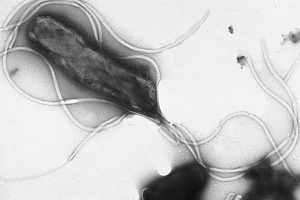Helicobacter pylori as a causative agent of Gastric Cancer: Difference between revisions
From MicrobeWiki, the student-edited microbiology resource
No edit summary |
No edit summary |
||
| Line 2: | Line 2: | ||
[[Image:EMpylori.jpg|EMpylori|thumb|300px|right|Transmission electron micrograph image of <i>Helicobacter pylori</i> taken by Dr. Yutaka Tsutsumi, Department of Pathology, Fujita Health University School of Medicine]] | [[Image:EMpylori.jpg|EMpylori|thumb|300px|right|Figure 1. Transmission electron micrograph image of <i>Helicobacter pylori</i> taken by Dr. Yutaka Tsutsumi, Department of Pathology, Fujita Health University School of Medicine]] | ||
[[Image:https://gi.jhsps.org/Upload/200802291540_18983_000.jpg|pylori|thumb|300px|right|Figure 2. Hematoxylin and eosin (H&E) stained histological section of the stomach mucosa indicating colonization of <i>H. pylori</i>. Courtesy of Johns Hopkins Medicine.]] | |||
[[Image:http://www.nature.com/nrc/journal/v4/n9/images/nrc1433-f1.jpg|pylori|thumb|300px|right|Figure 3. Induction of Cytoxin-associated gene A (CagA) gene by <i>H. Pylori</i> as a mechanism of cellular and DNA regulatory inhibition.]] | |||
[[Image:http://www.pubcan.org/images/large/Fig_4-04_A.jpg|pylori|thumb|300px|right|Figure 4. Advanced Gastric Carcinoma.]] | |||
Revision as of 03:43, 21 April 2015
Introduction
File:Https://gi.jhsps.org/Upload/200802291540 18983 000.jpg
Figure 2. Hematoxylin and eosin (H&E) stained histological section of the stomach mucosa indicating colonization of H. pylori. Courtesy of Johns Hopkins Medicine.
File:Http://www.nature.com/nrc/journal/v4/n9/images/nrc1433-f1.jpg
Figure 3. Induction of Cytoxin-associated gene A (CagA) gene by H. Pylori as a mechanism of cellular and DNA regulatory inhibition.
File:Http://www.pubcan.org/images/large/Fig 4-04 A.jpg
Figure 4. Advanced Gastric Carcinoma.
Other examples:
Bold
Italic
Subscript: H2O
Superscript: Fe3+
Section 1
Include some current research, with at least one image.
Section 2
Include some current research, with at least one image.
Conclusion
Overall text length should be at least 1,000 words (before counting references), with at least 2 images. Include at least 5 references under Reference section.
References
Edited by Alexandra Kruse, student of Joan Slonczewski for BIOL 238 Microbiology, 2015, Kenyon College.

